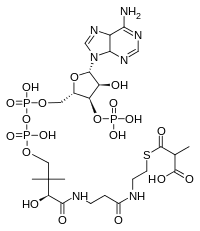Methylmalonyl-CoA
 | |
| Names | |
|---|---|
| IUPAC name
(9R)-1-[(2R,3S,4R,5R)-5-(6-Amino-9H-purin-9-yl)-4-hydroxy-3-(phosphonooxy)tetrahydro-2-furanyl]-3,5,9-trihydroxy-8,8,20-trimethyl-10,14,19-trioxo-2,4,6-trioxa-18-thia-11,15-diaza-3,5-diphosphahenicosan-21-oic acid 3,5-dioxide (non-preferred name) | |
| Identifiers | |
| 3D model (JSmol) |
|
| ChEBI | |
| ChemSpider | |
| PubChem CID |
|
| |
| |
| Properties | |
| C25H40N7O19P3S | |
| Molar mass | 867.608 g/mol |
| Except where otherwise noted, data are given for materials in their standard state (at 25 °C [77 °F], 100 kPa). | |
| | |
| Infobox references | |
Methylmalonyl-CoA is the thioester consisting of coenzyme A linked to methylmalonic acid. It is an important intermediate in the biosynthesis of many organic compounds as well as in the process of carbon assimilation.[1]
Biosynthesis and conversions
Methylmalonyl-CoA is formed from propionyl-CoA by propionyl-CoA carboxylase by help of biotin (vitamin B7). It is converted into succinyl-CoA by methylmalonyl-CoA mutase, in a reaction that requires vitamin B12 as a cofactor. In this way, it enters the Krebs cycle. The following diagram demonstrates the aforementioned reactions:[2]
- Propionyl CoA → Methylmalonyl CoA → Succinyl CoA
See also
References
- ↑ Tabita, F. R., "The hydroxypropionate pathway of CO2 fixation: Fait accompli", Proceedings of the National Academy of Sciences 2009, vol. 106, 21015-21016. doi:10.1073/pnas.0912486107
- ↑ Nelson, David L.; Cox, Michael M. (2005), Principles of Biochemistry (4th ed.), New York: W. H. Freeman, ISBN 0-7167-4339-6
This article is issued from
Wikipedia.
The text is licensed under Creative Commons - Attribution - Sharealike.
Additional terms may apply for the media files.